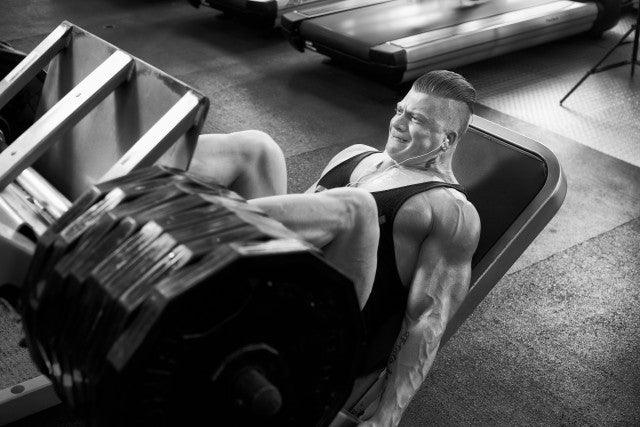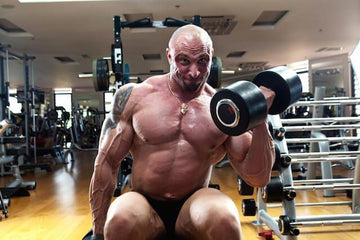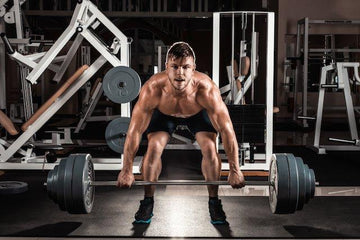

Do Knee Wraps Increase Muscle Growth of the Legs?
Table of Contents
Knee Wraps Decrease Muscle Activation of the Quadriceps.
by: Robbie Durand
The squat is the king of all leg exercises, but it’s not uncommon to see knee wraps being used by many recreational lifters while squatting. Knee wraps can definitely make you add more weight on the squat bar as knee wraps increase the amount of maximal weight that can be lifted. Most people use knee wraps to squat heavier hoping to increase the amount of muscle mass they put on their legs. During the downward phase of the squat, the tightness of the wraps allow for a high amount of elastic energy to be stored, which can subsequently be released during the upward phase—resulting in heavier and faster squats. Much like a spring that is being pushed down, the elastic energy storage results in a upward recoil. Knee wraps are commonly worn by competitive powerlifters and bodybuilders. The use of knee wraps is not without risks. In a previous study published in the Journal of Strength and Conditioning Research, researchers compared squats performed with and without knee wraps at 80 percent of the 1 RM. Trained college-age men were used and they performed three single repetitions of a back squat. The knee wraps provided a mechanical advantage, which was represented by the fact that the reps performed with wraps were completed faster. The amount of weight lifted was greater in the knee wraps groups but the knee wraps led to a restricted motion around the hip joint, which caused more upright posture and forced greater flexion at the knee joint. In essence, the knee wraps changes the way people squatted compared to squatting without knee wraps. New research published in the The Journal of Strength & Conditioning Research reports that using knee wraps at heavier loads also decreases muscle activation of the quadriceps compared to squatting without knee wraps.
Researchers measured the acute effects of knee wraps on knee and hip joint kinematics, dynamic muscle activation from the vastus lateralis and gluteus maximus, and rating of perceived exertion (RPE) during the back squat exercise at two different intensities. Fourteen resistance-trained men, performed one set of 3 repetitions under four different conditions, to a depth of ∼90 degrees of knee joint flexion, and in random order:
-with knee wraps at 60% 1RM,
-with knee wraps at 90% 1RM,
without knee wraps at 60% 1RM,
and without knee wraps at 90% 1RM.

At the end of the study, The researchers found that increasing the load from 60% of 1RM to 90% of 1RM increased the EMG activity in both vastus lateralis and gluteus maximus muscles. Knee wraps increased EMG activity in both muscles at 60% of 1RM but decreased EMG activity in the vastus lateralis at 90% of 1RM and left gluteus maximus EMG activity unchanged at 90% of 1RM. For normalized vertical barbell displacement, there were significant differences between intensities when using knee wraps. There were significant differences in RPE between 60 and 90% 1RM for each condition: with knee wraps, and without knee wraps. In conclusion, the use of knee wraps results in decreased muscle activation of the vastus lateralis at the same intensity (90%1RM). The use of knee wraps with high relative loads (90% of a 1-RM) led to reduced muscle activation of the vastus lateralis but not in the gluteus maximus. Most recreation bodybuilders use knee wraps to squat heavier and increase the size of their quads, but based on this new study, squatting at 90% of a 1-RM with knee wraps led to a decrease in quad activation. This kind of defeats the purpose in bodybuilding if your trying build bigger quads!
Lake, J., Carden, P., et al. Wearing Knee Wraps Affects Mechanical Output and Performance Characteristics of Back Squat Exercise. Journal of Strength and Conditioning Research. Decem 2011.
Gomes WA, Brown LE, Soares EG, Silva JJ, Silva FH, Serpa ÉP, Corrêa DA, Vilela
Junior GB, Lopes CR, Marchetti PH. KINEMATIC AND sEMG ANALYSIS OF THE BACK SQUAT AT DIFFERENT INTENSITIES WITH AND WITHOUT KNEE WRAPS. J Strength Cond Res. 2015 Mar 10.
MUSCLE MEDIA MAGAZINE FOR MEN
The premier source of training, nutrition, supplements, fat loss and health for men.

















